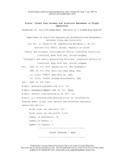JavaScript is disabled for your browser. Some features of this site may not work without it.
| dc.contributor.author | Yu, Chung-San | |
| dc.contributor.author | Wang, Eric Min-yang | |
| dc.contributor.author | Li, Wen-Chin | |
| dc.contributor.author | Braithwaite, Graham | |
| dc.date.accessioned | 2016-10-12T10:40:11Z | |
| dc.date.available | 2016-10-12T10:40:11Z | |
| dc.date.issued | 2014-04-18 | |
| dc.identifier.citation | Chung-san Yu, Eric Min-yang Wang, Wen-Chin Li and Graham Braithwaite. Pilots’ visual scan pattern and situation awareness in flight operations. Aviation, Space, and Environmental Medicine, Volume 85, Number 7, July 2014, pp708-714 | en_UK |
| dc.identifier.issn | 0095-6562 | |
| dc.identifier.uri | http://dx.doi.org/10.3357/ASEM.3847.2014 | |
| dc.identifier.uri | https://dspace.lib.cranfield.ac.uk/handle/1826/10706 | |
| dc.description.abstract | Introduction: Situation awareness (SA) is considered an essential prerequisite for safe flying. If the impact of visual scanning patterns on a pilot’s situation awareness could be identified in flight operations, then eye-tracking tools could be integrated with flight simulators to improve training efficiency. Method: Participating in this research were 18 qualified, mission-ready fighter pilots. The equipment included high-fidelity and fixed-base type flight simulators and mobile head-mounted eye-tracking devices to record a subject’s eye movements and SA while performing air-to-surface tasks. Results: There were significant differences in pilots’ percentage of fixation in three operating phases: preparation (M = 46.09, SD = 14.79), aiming (M = 24.24, SD = 11.03), and release and break-away (M = 33.98, SD = 14.46). Also, there were significant differences in pilots’ pupil sizes, which were largest in the aiming phase (M = 27,621, SD = 6390.8), followed by release and break-away (M = 27,173, SD = 5830.46), then preparation (M = 25,710, SD = 6078.79), which was the smallest. Furthermore, pilots with better SA performance showed lower perceived workload (M = 30.60, SD = 17.86), and pilots with poor SA performance showed higher perceived workload (M = 60.77, SD = 12.72). Pilots’ percentage of fixation and average fixation duration among five different areas of interest showed significant differences as well. Discussion: Eye-tracking devices can aid in capturing pilots’ visual scan patterns and SA performance, unlike traditional flight simulators. Therefore, integrating eye-tracking devices into the simulator may be a useful method for promoting SA training in flight operations, and can provide in-depth understanding of the mechanism of visual scan patterns and information processing to improve training effectiveness in aviation. | en_UK |
| dc.language.iso | en | en_UK |
| dc.publisher | Aerospace Medical Association | en_UK |
| dc.rights | Published by Aerospace Medical Association. This is the Author Accepted Manuscript. This article may be used for personal use only. The final published version (version of record) is available online at DOI:10.3357/ASEM.3847.2014. Please refer to any applicable publisher terms of use. | |
| dc.subject | attention allocation | en_UK |
| dc.subject | aviation safety | en_UK |
| dc.subject | fixation duration | en_UK |
| dc.subject | training evaluation | en_UK |
| dc.title | Pilots’ visual scan pattern and situation awareness in flight operations | en_UK |
| dc.type | Article | en_UK |
Files in this item
This item appears in the following Collection(s)
-
Staff publications (SATM) [4365]
